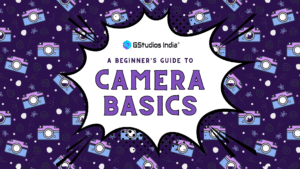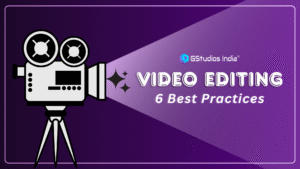🎥 What is Video Editing?
Video editing is the process of arranging and refining different components of a video.This process creates the illusion that the shots were filmed in a single location. Video editing is performed using computer software that enables the rearrangement and manipulation of footage. The process of video editing involves arranging footage in a way that creates a narrative or a story. This process showcases advanced techniques, yielding visually stunning results. It highlights the raw beauty of the chosen subject.
💻 How Does Video Editing Fit into Today’s World?
Video editing enables you to express your creativity and unleash your passion for storytelling. It involves conveying a narrative through audio and visual elements.
Storytelling is about engaging the audience and creating a compelling viewing experience. Taking action on your thoughts and goals is the best way to advance them. From brainstorming sessions to strategy, Editing puts your imagination and originality to work.
In today’s digital age, the value of digitization cannot be overstated. Video editing is a crucial component of producing appealing and interesting material. It allows for the production of diverse media formats. It allows you to create smooth transitions and distinctive effects. It also involves implementing soundtracks and sound effects to create a specific mood or atmosphere.
The creation and sharing of videos on social media platforms have become integral to interaction and entertainment. With the growing consumption of digital content, video editing has emerged as an essential skill in the contemporary landscape. As a result, video editing is now one of the most sought-after careers in the world. The field covers many areas such as:

- Content developers
- Film editors
- Video content creators
- Multimedia designers
- Animators
- Broadcast engineers
✂️ Why Is Video Editing So Important?
Video editing holds significance for several key reasons.
It Enables You to Provide Visually Compelling and Engaging Content
Adjusting the visual and auditory components can enhance a video’s storyline and overall impact. which will attract and engage viewers better. To craft engaging content, video editors utilize visual elements like shot selection, angles, and framing. Techniques such as these can be used:
- Shot Selection: Select the ideal angles and images to communicate the story. This establishes a specific tone or atmosphere.
- Framing: Utilizing various framework techniques, which include close-ups, medium shots, and wide shots. To generate aesthetic value and communicate details about characters and the setting.
- Camera Movement: To increase visual appeal and impart details about the mobility and motion in the picture. The filmmakers often use methods like panning, tilting, and tracking angles.
- Color Grading: Creating a certain mood or atmosphere by applying color correction and color grading procedures to a film.
- Lighting: Employing lighting techniques to render the video aesthetically appealing. And to evoke a certain tone or vibe.
Employing these techniques is crucial for video editors aiming to captivate and maintain viewers’ attention.
It Provides Seamless Transitions and Special Effects
Transitions and special effects are critical elements of video editing that enhance a video’s aesthetic appeal and effectiveness.
- Transitions: To create a fluid and continuous movement across frames, transitions are employed to link each shot to the following. Transitions that are frequently used include cuts, dissolves, wipes, and fades. Such transitioning can be employed to denote a shift in the present, the past, or the feelings.
- Special Effects: To enhance a video’s aesthetic appeal as well as authenticity, special effects are applied. Composting, motion graphics, 3D animation, and visual effects are a few examples of these. Explosions, shooting, weather effects, and other features are samples of special effects.
These effects can help establish a specific tone or atmosphere while enhancing the video’s visual appeal. Additionally, they can give a video a sense of progression, coherence, and clarity. Despite their repetition, transitions, and special effects should be handled tastefully and sensibly since they can distract from the narrative.
It Facilitates Establishing the Desired Ambiance or Mood
Storytelling involves establishing a desired mood or atmosphere, also called a “tone” or an “ambiance”, in video editing. This is achieved through various visual and audio elements. For example shots, angles, framing, lighting, color grading, music, and sound effects. It is important to ensure that the intended atmosphere or mood remains consistent throughout the video. thus should complement its main plot or theme.
- Lighting and Color Grading: An atmosphere or mood can be produced using lighting and color grading. For instance, warm hues can evoke memories of the past or romanticism. Whereas cool hues can evoke a sense of intrigue or excitement.
- Music and Sound Effects: To set a certain tone or ambiance, you can use audio and soundtracks. A fast-paced, uplifting genre of music, for instance, can evoke excitement or action. Whereas a slow, somber music composition can evoke grief or drama.
- Camera Movement and Shot Selection: A video’s visuals and storytelling are greatly influenced by camera movement and shot selection. Panning, tilting, tracking, and dollying are some of the camera movements.
- Framing and Composition: You can use framing and composition to establish a particular tone or vibe. A close-up shot, for instance, can convey tenderness, intimacy, or drama. Whereas a wide shot can convey magnificence or epic.
It Makes Information Transmission More Effective
Simple and succinct course material that can be utilized for coaching, educational, or informational purposes can be made using video editing. To guarantee that the finished product matches the required criteria and is finished on time, information must be communicated effectively.
- Setting clear goals and expectations: Make very sure the customer is aware of the desired appearance of the product before beginning the editorial process.
- Use project management tools: This makes it possible for all colleagues to stay in touch, keep an eye on deadlines, and observe how the project is progressing.
- Establish a clear workflow: This makes sure that everybody is aware of their duties and guarantees that the creative process is efficient.
- Review progress: This enables the team to identify any problems or errors straight on and address them before anything worsens.
- Use clear and concise language: Use caution when using jargon (Terminology ). Speak in layman’s terms while interacting with group mates.
- Use annotations, notes, or comments while editing videos: this enables you to add precise guidelines or criticism to the footage for a quick overview.
Crucial Factors for Social Media and Digital Content
Video editing is becoming an essential tool for making and distributing content on social media networks. This reflects the increasing demand for digital content.
- Research: The creation stage might be informed by social media research on prominent and emerging information kinds.
- Promotions: Social media can be utilized to market the content and reach a wider target audience when the workflow is over.
- Collaborations: Social networking can be used to identify and employ independent editors as well as to interact with other experts.
- Sharing and Distribution: Key platforms for publishing and sharing finished videos include YouTube, Vimeo, TikTok, Instagram, and Facebook.
- Feedback and Engagement: Social media is a fantastic tool for communicating with your target audiences. Subsequent videos can be improved with the help of this criticism and suggestions.
- Monetization: The videos can also earn profits off of social media networks through partnerships, adverts, or products.
📚 Conclusion
Video editing is a crucial component of the production process that can significantly enhance the aesthetic impact of a story, as well as its ability to convey information, entertainment, and education. Because it enables the creation of a refined, expert end product, video editing is an essential stage in the video production process. The ability to regulate the pace of the video for the intended audience during editing allows the editor to create a concise and compelling story that will engage the viewer.
To make the information more appealing, it is also important to develop a unique look and feel that is consistent with the overall purpose and concept of the film. This can be done by enhancing the audio or deleting unnecessary footage, resulting in a more polished final product. Video editing enables the editor to create a consistent visual identity, enhancing the ability to effectively reach the intended audience and build brand recognition. Video editing also allows the editor to tailor the film to the client’s needs, making it look more polished and professional.
In summary, video editing is a vital stage in the production process, allowing for the creation of a polished and professional final product that effectively conveys a narrative, manages pacing, and enhances the viewer’s experience.
✨ Want to dive deeper into video editing?
Join our exclusive courses designed for aspiring filmmakers! With limited seats available, be sure to book your FREE CONSULTATION today and take your skills to the next level!
Authored and Graphics by – Divyangi Jain





